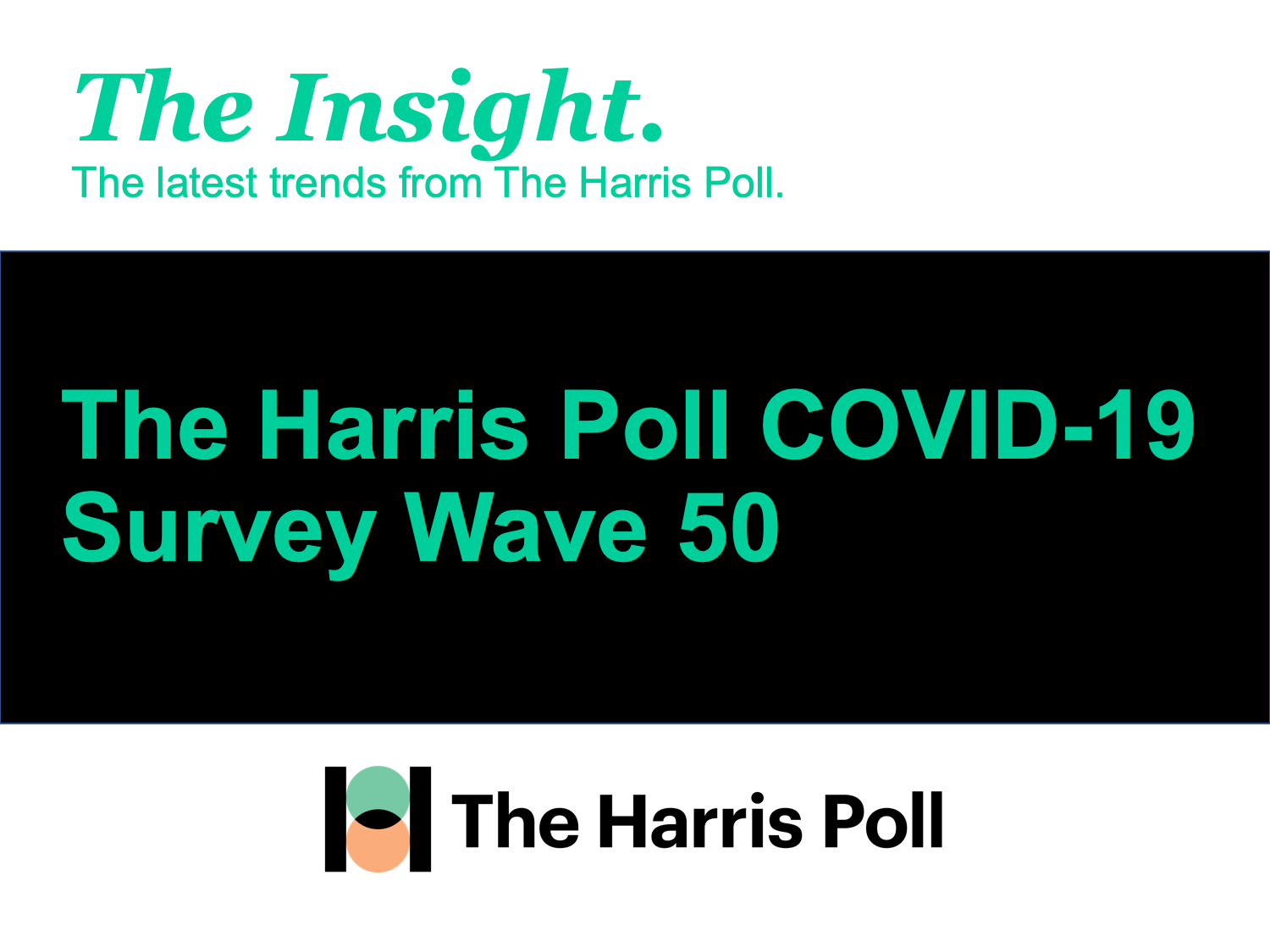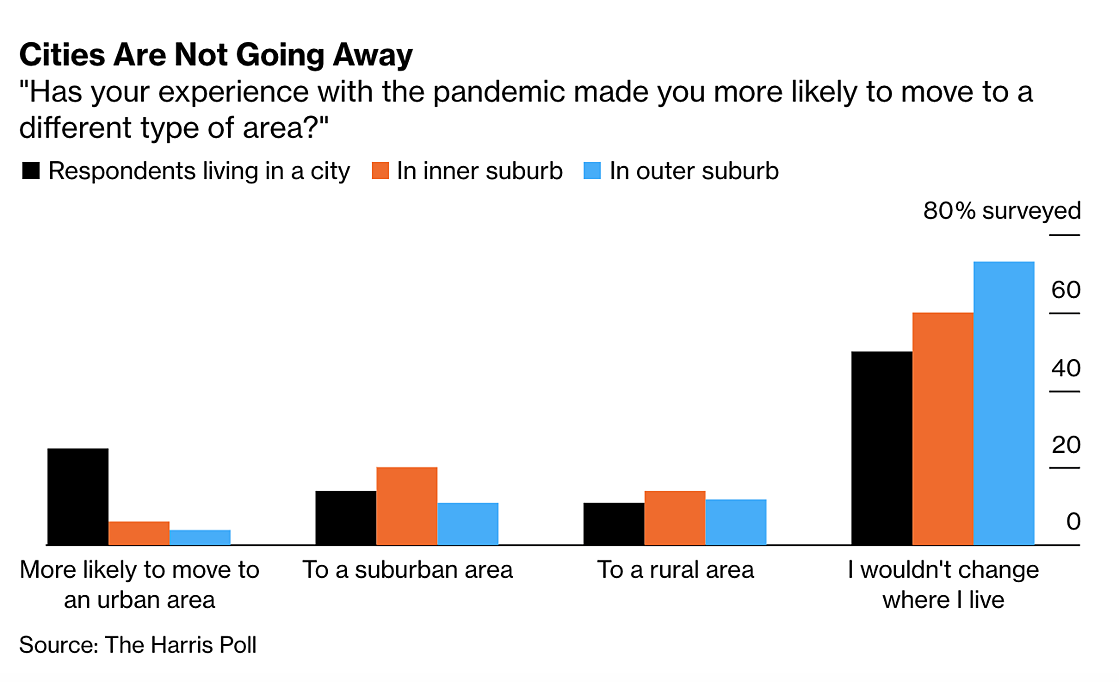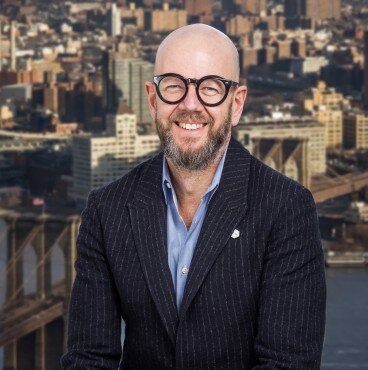Brief • 4 min Read

In The Harris Poll COVID-19 Tracker (Week 50) fielded February 5th to 7th, 2021 among 2,043 U.S. adults, we look at the resilience of cities in the pandemic, a check-in on new COVID variants, how Americans feel about reopening schools, attitudes towards raising the minimum wage, and which micro-industries will take off after the return to normal.
As a public service, our team has curated key insights to help leaders navigate COVID-19. Full survey results, tables, and weekly summaries can be accessed for free at The Harris Poll COVID-19 Portal. We will continue to actively field on a regular cadence to track the shifts in sentiment and behaviors as the news and guidelines evolve.
Lastly, mark your calendars for Thursday, 2/12 at 12pm ET and join us with OAAA for this week’s Lunch Break: OAAA and Harris Poll will release new research that highlights the key role OOH will continue to play in consumer journeys & disseminating public safety messages during the recovery. http://bit.ly/3rA61oh
Why We Don’t Believe the Big City Obituary: Bloomberg-Harris Poll
A new survey by The Harris Poll and the Chicago Council on Global Affairs, featured in Bloomberg, looks at the attitudes about urban and suburban life among the nation’s six largest metropolitan areas and how they feel about the places they live during the pandemic.
- Since the outset of the pandmeic, many have been predicting a mass retreat from urban life. “New York City is dead forever,” declared a viral LinkedIn post in August. Last year “ended the boom of cities that started in the 1990s,” announced a recent op-ed in The Hill. Even our own article with Axios from April 2020 saw urbanites eyeing a migration from cities.
- After a year of living with COVID-19, the survey found no evidence of a long-term urban exodus. The bulk of residents across community type — big city, inner suburb and outer suburb — are happy with where they live, and say they want to live in the type of community in which they currently reside.
- When asked specifically how their pandemic experience has affected their preferences, half of city residents say it has not changed where they prefer to live. Another (25%) say the pandemic actually makes them more likely to move to another urban area.
- Surprisingly, the survey found similar responses across income, race, education level and family status. Even those from households with children — people especially affected by lockdown and remote learning — are evenly divided on whether their pandemic experience has made them prefer suburban (20%) or urban living (19%). And of those in Generation Z (ages 18-24), many more say they want to live in big cities (39%) than in suburbia (25%), the lowest result of any age cohort.

Takeaway: If our cities recover, as we believe they will, it will be a credit to the commitment, sacrifice and imagination of their citizens — the millions already there and those who move to join them. Even today, cities remain the place to be.
COVID Variants Signal New Concerns and Urgency for the Vaccine Roll Out
The majority (86%) of Americans are aware that the new COVID-19 variants identified in the United Kingdom, Brazil, and South Africa (B.1.351), have now been found in the U.S. And over three quarters (77%) are concerned. Here’s what else we found:
- Vaccinated Americans are among the most concerned (82%) about new variants. Even though there is now real evidence that one of the variants poses a threat to vaccine power, scientists stress the vaccines still appear to protect people from the worst outcomes, like hospitalization or death.
- Dr. Fauci and other experts urge this is even more reason to step up vaccination campaigns: “Viruses cannot mutate if they can’t replicate,” Fauci said Monday at a press conference by the White House’s COVID-19 response team. Our data indicates more and more Americans are coming around to getting vaccinated; today (69%) say they are likely to get the vaccine as soon as it’s available.
- Still just under half (44%) say they disapprove of how the vaccine distribution is going here in the U.S. and (59%) say “At the moment, I feel there is too much conflicting information about the COVID-19 vaccines that I am not sure who to trust.”
- Early data signals racial disparities across COVID-19 vaccine rollout, due to lack of information and mistrust in the healthcare systems, a trend mirrored in our data: (80%) of White vs (69%) Black Americans say they are aware of vaccine eligibility in their area and (41%) of White vs (28%) Black Americans said they’ve registered for an appointment to receive a COVID19 vaccine. And, (64%) of White vs only (50%) of Black and (47%) of Hispanics say they would be comfortable receiving the vaccine from their doctor’s office.
- Community mindsets matters: (57%) of Black and Hispanics say “Hearing about others who are skeptical of the safety of the COVID-19 vaccine is making me rethink if I should get the vaccine myself” vs (42%) White. And, (59%) of Black vs (45%) White Americans say “drug companies experimenting on consumers” is a valid reason for vaccine skepticism.
Takeaway: The arrival of new variants accelerates the urgency to increase communication and education on the vaccines, especially for minority communities who are at higher risk and also (rightfully so) have a higher degree of distrust of the vaccines given a troubling history with the healthcare system.
Reopening Schools in the Pandemic
Late last month, the Centers for Disease Control and Prevention (CDC) announced in-person schooling can be done safely if proper precautions such as mask-wearing, social distancing, and local community restrictions are taken, even before teachers receive vaccinations. This week we asked Americans how they feel about reopening schools:
- Americans are divided on how schools should be operating in their area: nearly one-third (32%) say they should be using a hybrid approach, while (28%) say they should be held entirely in-person and (27%) held entirely online.
- A racial disparity exists in trust to reopen safely: Though a majority (63%) of Black Americans trust their local school system to operate in-person safely given COVID, they still lag White Americans by a wide-margin (78%).
- The New York Times profiles the struggle facing many Black families: “deep-seated mistrust among Black families toward their public school districts is holding back school reopening, even as Black children suffer inordinately from remote learning.” And Black Americans are more likely than White Americans to favor schooling entirely online (34% vs 23%).
- Schools without vaccines: Most Americans (80%) say it is important to vaccinate teachers before resuming any in-person classes. Though, a political gap exists: nearly all (91%) of Democrats vs (70%) of Republicans saying the requirement is important.
Takeaway: Dr. Margaret Honein, a member of the CDC’s COVID emergency response team, summarizes what we’ve learned: “[Last year], we did not have a lot of data on whether or not we would see the same sort of rapid spread in schools that we had seen in other high-density […] sites. But there is accumulating data now that with high face mask compliance, and distancing and cohorting of students to minimize the total number of contacts, we can minimize the amount of transmission in schools.”
83% of Americans Say $7.25 Minimum Wage Is Not Enough: Yahoo Finance-Harris Poll
Americans overwhelmingly agree the federal minimum wage should be increased, but many people think it should be considered separately from the next COVID-19 relief bill, according to new findings from Yahoo Finance and the Harris Poll.
- Most Americans support raising the minimum wage: When asked what is the highest minimum wage they would support, most people chose the range of $10 to $15 an hour. More than one-third (35%) – the largest share of respondents – said they’d support between $13-$15 an hour, (29%) would support $10 to $12, and (13%) would back a hike to more than $15 an hour (which Congress is not considering).
- High earners, college educated disconnected from realities of minimum wage: (83%) of Americans agreed that a person working a full-time job at the current minimum wage of $7.25 an hour isn’t making enough money to live.
- People in households making more than $100,000 a year were most likely to think a full-time minimum wage job was enough for people to get by, according to the poll. More than one-quarter (28%) of high-earners said $7.25 an hour was enough to live on, while just (12%) of those in households making less than $50,000 annually said $7.25 wage sufficed.
- Americans see a minimum wage hike as having a positive economic impact: (59%) of Americans believe raising the minimum wage would have a positive impact on the economy.
Takeaway: The Economist explores the history of raising the minimum wage: “The world has little experience of large minimum-wage rises, and they could cost an economy jobs. Yet history also suggests that such increases, implemented with care, may nonetheless have beneficial longer-term effects.”
Which Micro-Industries Will Boom Post-COVID?
The COVID-19 pandemic has upended nearly every industry, making some “micro” industries newly integral to our lives while causing others to become relics of the past. We asked consumers which industries they expect to see a boom, which ones will suffer, and which ones will stay the same as before, after things “return to normal.” Here’s what we found:
- Experience seekers go long on travel and events: Americans say tourism (51%), airlines (48%), and ‘experiences’ like concerts and sporting events (46%) will boom when we return to normal.
- Industries of the future will take off: About 3 in 10 also see a boom for solar energy (30%), cannabis (29%), telehealth (26%), and sports gambling (23%) after COVID.
- Revenge spending at “mom and pops”: Despite local retailers being some of the hardest hit businesses, more than one-third (35%) say “mom and pop” retailers will boom after the pandemic, while (27%) say they will suffer. Rural Americans (39%) are more likely than Urbanites (30%) to think “mom and pop” retailers will see a boom.
- Virtual workouts, the necessary evil of COVID, might stick around: more than one-fifth (22%) expect online fitness to boom after the pandemic, while half (48%) say they expect it to remain unchanged. We asked Americans what they’ll do after the pandemic ends: one-quarter (26%) say they’ll stick with virtual workout classes only while (35%) say they’ll be doing a hybrid of virtual and in-person workouts.
Takeaway: The Wall Street Journal profiles how “cannabis companies are ready to roll” due to a combination of strong sales during the pandemic, easing regulations, and COVID-inspired innovations like online ordering and curbside pickup.
Subscribe for more Insights
Subscribe to our newsletter for the latest trends in business, politics, culture, and more.
Download the Data
This survey was conducted online within the U.S. by The Harris Poll from February 5 to 7, 2021 among a nationally representative sample of 2,043 US. adults.
Download
Subscribe for more Insights
Subscribe to our newsletter for the latest trends in business, politics, culture, and more.
Download the Data
This survey was conducted online within the U.S. by The Harris Poll from February 5 to 7, 2021 among a nationally representative sample of 2,043 US. adults.
DownloadRelated Content








